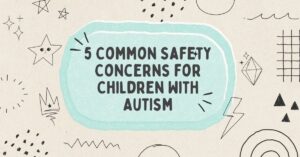
As a parent, your child’s safety is often on your mind. For those with a child diagnosed with autism, the worry may become an all-encompassing part of your day-to-day life. Although some level of concern will always be there, gaining awareness about what to do about safety issues and how to prevent potential problems could go a long way. Read on for five of the most common safety concerns for children with autism.
According to the Autism Family Safety Handbook, “Many people with ASD do not recognize or understand safety issues at home, in school, at work, and in the community.”
It may be valuable to see where five of the most common areas of safety concerns are for children with autism so that you can prepare accordingly. Some of these include:
-
Sensory Issues – Whether it’s a series of loud noises or the texture of one’s clothing against their skin, children with autism can be extremely sensitive to various stimuli. When overstimulated, a child with autism may wander off or seek an escape from the sound, feeling, or sensation. There are also children with autism who have a delayed sense of perception of pain or temperature, which could lead to a dangerous situation.
-
Environmental Unawareness – Not understanding what a gas burner is or what an electrical socket does could lead to an accident. Taking an inventory of all the appliances, items, and environmental stimuli that may impact your child is a great place to start when assessing household safety.
-
Poisonous Materials – Medications that look like candy to cleaning fluids that look like fruit juice are toxic – storing these dangerous substances in a safe location can help protect children with autism who may not understand what they are consuming and how it may be dangerous to their health.
-
Water – From being attracted to a shiny spot in a pond to stumbling into a bathtub filled with water, being unsupervised around water can be a real risk for children with autism. According to a study conducted by researcher Joseph Guan, accidents related to water and individuals with autism are most common close to home.
-
Fire – Many children with ASD may not understand what a fire is and the level of injury it can cause. Even if the child avoids sustaining a serious injury, a lack of knowledge and parental awareness could lead to property destruction and other damage.
Accident Prevention: Potential Risk Reduction for Your Children
Although there is no single “right way” of keeping your child safe from the safety concerns above, there are simple preventative measures you can take before an accident occurs. Safety may also be something that an ABA therapist may want to teach your child about. An ABA therapist will be able to break down complex tasks into more digestible actions and help your child grow and better understand what to do to stay safe and avoid harm.
Below are some ways that may help your family understand what to do or what may be done by an ABA therapist to lessen
the risk of a safety issue.
-
Sensory Issues – Sensory issues are so personalized that a strategy that works for your child may not work for another family. From wearing sensory headphones in a loud environment to having an ABA therapist explain the danger of touching a hot pan, finding out what works best for your child may consist of several different strategies.
-
Environmental Unawareness – It may be necessary to put safety devices on gas switches, hot faucets, or toilet handles. It also may be helpful to remove or bolt down any equipment or furniture that could fall onto your child. When possible, try to explain to your child what each of these things does and why they may be harmful to them.
-
Poisonous Materials – Always keep medications or other potentially hazardous items secured and labeled with what they are. You should also have the phone number ready for the Poison Control Center in case there ever is an accident.
-
Water – Teaching your child with autism how to swim is one of the best defenses against water-related accidents. Learning CPR and securing your pool, or other water sources, could also lessen the chances of a serious accident or injury taking place.
-
Fire – Have an escape plan in case a fire does ever occur and practice it frequently. Having a conversation with first responders may also be helpful for your family. It may be important to talk to them about a safe space that a person with autism may go to, alternative fire alarm systems, or stick a decal on a window or door so that they know that there is a child with autism who lives in the house.
Learning From the Professionals
Whether it’s in your home or at an ABA therapy center where you can practice safety skills in a controlled environment, the best way for your child with autism to learn about personal safety is through a trained ABA therapist. If you want to see if your child is eligible for ABA therapy, click here.




